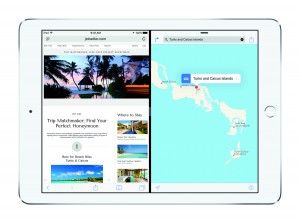Here are my brief reactions to the new products that Apple announced at its media event yesterday:
• Watch
So now you can get a gold Apple Watch for the same price as a Sport model. Actually, it is a Sport model. Apple now offers two new gold finishes for its aluminum Watch. You have to wonder if these colors were held back from last spring’s initial release so as not to give any competition to the actual gold models. Perhaps due to poorer than expected sales, Apple no longer cares about potential competition. In any case, yesterday’s event made no mention of the uber-expensive models.
• iPad
The 12.9” iPad Pro is quite attractive overall — especially so for people seeking Apple’s answer to the laptop/tablet Microsoft Surface. If I was in the market for such a device, I’d get one. [By the way, I predicted an iPad Pro back in January 2014 — and was quite close to what Apple released yesterday.]
The new connector technology used by the Keyboard seemed very cool. I look forward to see what third parties will do with it. I don’t see using the Pencil (I remain with Steve Jobs here), but I can imagine it being useful in specific applications.
On the downside, I’m bummed that the iPad Pro doesn’t include the 3D Touch feature announced for the new iPhones. It seems like a glaring omission…to have Apple’s most expensive iOS device lacking a key feature available in its smallest one.
A larger problem for Apple is (other than a minor update to the iPad mini — which Apple should have released last year), there were no other new iPads. Most especially, there was no iPad Air 3. This means that, unless you want an iPad Pro, there is almost no incentive for current iPad owners to upgrade to a new model. As such, I expect iPad sales for the coming holiday season to continue its decline. I don’t see the iPad Pro generating enough sales to reverse the trend.
• iPhone
With 3D Touch and an improved camera that includes Live Photos and 4K video, the iPhone 6S and 6S Plus offer new features that are significant enough to motivate a substantial number of current users to upgrade. I expect the new iPhones to continue to gain market share and solidify Apple’s lead. Well done.
• TV
For me, the new Apple TV was the most “drool-worthy” of all the products announced yesterday. The new remote with a touch surface and Siri support can potentially change how we interact with television. As someone with the beginnings of hearing loss, I was especially blown away by the “What did he say?” feature, which rewinds 15 seconds and plays it back with captions.
For a long time, I have been advocating for the Apple TV to include its own App Store and provide better support for games. The new Apple TV delivers in both these categories. Yes!
Still, I do have a couple of concerns. No 4K support? This was a surprise, especially since the new iPhones can produce 4K video. And I didn’t see any option to play ripped DVDs, as you can do via the Computers icon in the current Apple TV. In fact, I didn’t see a Computers icon at all. Maybe it’s there and just not mentioned. We’ll see.
According to one article I read, analysts were overall left “underwhelmed” with the new Apple TV. They wanted to see the promised subscription service (and perhaps even original content). I too want a subscription service (especially if it means I can dump Comcast). But I have patience. I assume it will arrive in due course next year. I’d also like some sort of iCloud-based DVR, but I doubt I will see that. In the meantime, the new Apple TV is already a fantastic upgrade. I want one yesterday.
• Mac
One last thing. There was no mention of the Mac at the media event yesterday. Not even the impending release of OS X El Capitan (due September 30). Perhaps there will be some new Mac announcements in the weeks ahead, without a corresponding media event (because the iPad Pro was revealed yesterday, I no longer expect a separate event in October). Otherwise, we’ll have to wait till 2016 for new Macs.

